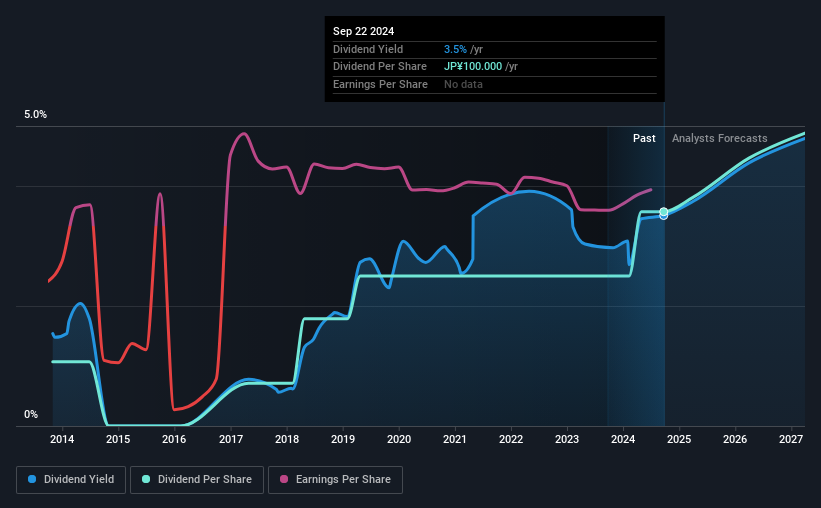Is It Worth Considering Tokuyama Corporation (TSE:4043) For Its Upcoming Dividend?

Tokuyama Corporation (TSE:4043) is about to trade ex-dividend in the next 3 days. The ex-dividend date is one business day before a company's record date, which is the date on which the company determines which shareholders are entitled to receive a dividend. The ex-dividend date is important because any transaction on a stock needs to have been settled before the record date in order to be eligible for a dividend. This means that investors who purchase Tokuyama's shares on or after the 27th of September will not receive the dividend, which will be paid on the 2nd of December.
The company's upcoming dividend is JP¥50.00 a share, following on from the last 12 months, when the company distributed a total of JP¥100.00 per share to shareholders. Calculating the last year's worth of payments shows that Tokuyama has a trailing yield of 3.5% on the current share price of JP¥2850.50. Dividends are a major contributor to investment returns for long term holders, but only if the dividend continues to be paid. We need to see whether the dividend is covered by earnings and if it's growing.
See our latest analysis for Tokuyama
Dividends are typically paid out of company income, so if a company pays out more than it earned, its dividend is usually at a higher risk of being cut. Fortunately Tokuyama's payout ratio is modest, at just 28% of profit. That said, even highly profitable companies sometimes might not generate enough cash to pay the dividend, which is why we should always check if the dividend is covered by cash flow. It paid out 21% of its free cash flow as dividends last year, which is conservatively low.
It's positive to see that Tokuyama's dividend is covered by both profits and cash flow, since this is generally a sign that the dividend is sustainable, and a lower payout ratio usually suggests a greater margin of safety before the dividend gets cut.
Click here to see the company's payout ratio, plus analyst estimates of its future dividends.

Have Earnings And Dividends Been Growing?
Companies with falling earnings are riskier for dividend shareholders. Investors love dividends, so if earnings fall and the dividend is reduced, expect a stock to be sold off heavily at the same time. Readers will understand then, why we're concerned to see Tokuyama's earnings per share have dropped 10% a year over the past five years. Ultimately, when earnings per share decline, the size of the pie from which dividends can be paid, shrinks.
Many investors will assess a company's dividend performance by evaluating how much the dividend payments have changed over time. In the last 10 years, Tokuyama has lifted its dividend by approximately 13% a year on average.
To Sum It Up
Should investors buy Tokuyama for the upcoming dividend? Earnings per share are down meaningfully, although at least the company is paying out a low and conservative percentage of both its earnings and cash flow. It's definitely not great to see earnings falling, but at least there may be some buffer before the dividend needs to be cut. Overall, it's not a bad combination, but we feel that there are likely more attractive dividend prospects out there.
While it's tempting to invest in Tokuyama for the dividends alone, you should always be mindful of the risks involved. To help with this, we've discovered 1 warning sign for Tokuyama that you should be aware of before investing in their shares.
A common investing mistake is buying the first interesting stock you see. Here you can find a full list of high-yield dividend stocks.
Valuation is complex, but we're here to simplify it.
Discover if Tokuyama might be undervalued or overvalued with our detailed analysis, featuring fair value estimates, potential risks, dividends, insider trades, and its financial condition.
Access Free AnalysisHave feedback on this article? Concerned about the content? Get in touch with us directly. Alternatively, email editorial-team (at) simplywallst.com.
This article by Simply Wall St is general in nature. We provide commentary based on historical data and analyst forecasts only using an unbiased methodology and our articles are not intended to be financial advice. It does not constitute a recommendation to buy or sell any stock, and does not take account of your objectives, or your financial situation. We aim to bring you long-term focused analysis driven by fundamental data. Note that our analysis may not factor in the latest price-sensitive company announcements or qualitative material. Simply Wall St has no position in any stocks mentioned.
About TSE:4043
Flawless balance sheet and good value.
Similar Companies
Market Insights
Community Narratives


